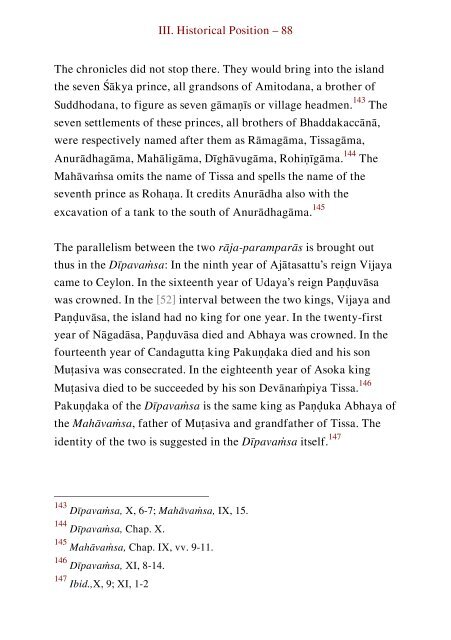On the Chronicles of Ceylon
A judicious appraisal of the various Chronicles that were written in Sri Lanka, assessing their chronology, literary and historical character.
A judicious appraisal of the various Chronicles that were written in Sri Lanka, assessing their chronology, literary and historical character.
- No tags were found...
You also want an ePaper? Increase the reach of your titles
YUMPU automatically turns print PDFs into web optimized ePapers that Google loves.
III. Historical Position – 88<br />
The chronicles did not stop <strong>the</strong>re. They would bring into <strong>the</strong> island<br />
<strong>the</strong> seven Śākya prince, all grandsons <strong>of</strong> Amitodana, a bro<strong>the</strong>r <strong>of</strong><br />
Suddhodana, to figure as seven gāmaṇīs or village headmen. 143 The<br />
seven settlements <strong>of</strong> <strong>the</strong>se princes, all bro<strong>the</strong>rs <strong>of</strong> Bhaddakaccānā,<br />
were respectively named after <strong>the</strong>m as Rāmagāma, Tissagāma,<br />
Anurādhagāma, Mahāligāma, Dīghāvugāma, Rohiṇīgāma. 144 The<br />
Mahāvaṁsa omits <strong>the</strong> name <strong>of</strong> Tissa and spells <strong>the</strong> name <strong>of</strong> <strong>the</strong><br />
seventh prince as Rohaṇa. It credits Anurādha also with <strong>the</strong><br />
excavation <strong>of</strong> a tank to <strong>the</strong> south <strong>of</strong> Anurādhagāma. 145<br />
The parallelism between <strong>the</strong> two rāja-paramparās is brought out<br />
thus in <strong>the</strong> Dīpavaṁsa: In <strong>the</strong> ninth year <strong>of</strong> Ajātasattu’s reign Vijaya<br />
came to <strong>Ceylon</strong>. In <strong>the</strong> sixteenth year <strong>of</strong> Udaya’s reign Paṇḍuvāsa<br />
was crowned. In <strong>the</strong> [52] interval between <strong>the</strong> two kings, Vijaya and<br />
Paṇḍuvāsa, <strong>the</strong> island had no king for one year. In <strong>the</strong> twenty-first<br />
year <strong>of</strong> Nāgadāsa, Paṇḍuvāsa died and Abhaya was crowned. In <strong>the</strong><br />
fourteenth year <strong>of</strong> Candagutta king Pakuṇḍaka died and his son<br />
Muṭasiva was consecrated. In <strong>the</strong> eighteenth year <strong>of</strong> Asoka king<br />
Muṭasiva died to be succeeded by his son Devānaṁpiya Tissa. 146<br />
Pakuṇḍaka <strong>of</strong> <strong>the</strong> Dīpavaṁsa is <strong>the</strong> same king as Paṇḍuka Abhaya <strong>of</strong><br />
<strong>the</strong> Mahāvaṁsa, fa<strong>the</strong>r <strong>of</strong> Muṭasiva and grandfa<strong>the</strong>r <strong>of</strong> Tissa. The<br />
identity <strong>of</strong> <strong>the</strong> two is suggested in <strong>the</strong> Dīpavaṁsa itself. 147<br />
143 Dīpavaṁsa, X, 6-7; Mahāvaṁsa, IX, 15.<br />
144 Dīpavaṁsa, Chap. X.<br />
145 Mahāvaṁsa, Chap. IX, vv. 9-11.<br />
146 Dīpavaṁsa, XI, 8-14.<br />
147 Ibid.,X, 9; XI, 1-2


















